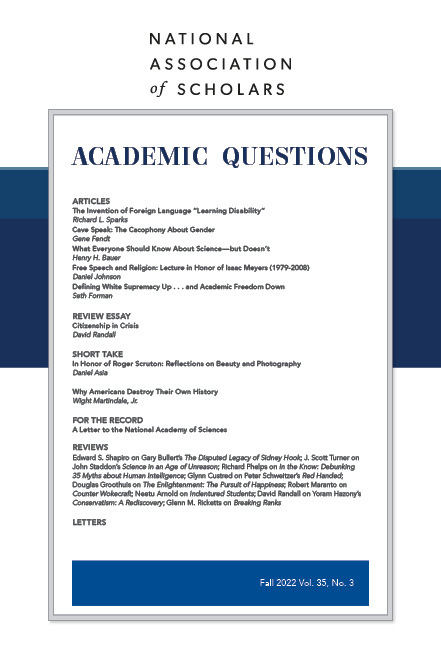In the Know: Debunking 35 Myths about Human Intelligence, Russell T. Warne, Cambridge University Press, 2020, pp. 418, $99 hardcover, $25.99 paperback, $21 e-book.
Richard Phelps is founder of the Nonpartisan Education Review (http://www.nonpartisaneducation.org); [email protected]. His most recent books are Defending Standardized Testing (Psychology Press, 2005), Standardized Testing Primer (Peter Lang, 2007), and Correcting Fallacies about Educational and Psychological Testing (American Psychological Association, 2009). Phelps appeared in AQ in Fall 2021 with “The Politicization of Education Research and the AERA.”
For decades, the indefatigable Will Fitzhugh has refused to stop reminding us of a stark and stubborn paradox of American culture, both apparent and hidden at virtually every U.S. public school. We fastidiously measure observable variations in athletic skill and ability and celebrate those who excel. Meanwhile, we shush and shame those who attempt the same in the cognitive domain. The outfall of this profound bias can be seen in the tables of content of Fitzhugh's Concord Review, where high school students publish excellent long form scholarly history journal articles. Scan the names of the authors and the locations of their schools over the past few decades and one cannot help but notice the trend—away from American-born authors and toward students raised elsewhere, some now attending U.S. private schools as international students, but many still residing at home overseas. And this not in a STEM field, but in the humanities.
Russell T. Warne's, In the Know: Debunking 35 Myths about Human Intelligence, ably illustrates another consequence of the suppression of information about intelligence—the size of the chasm that now separates a well-developed subfield of psychological science (perhaps the most developed subfield) and public perceptions of same, even among the otherwise well-educated. In the Know is Warne's attempt to bridge that chasm.
Warne asserts
it is disheartening that there are so many incorrect beliefs about intelligence. I cannot think of another topic in psychology that is the subject of so many widespread misconceptions. (336)
It is also unfortunate that it takes courage to write about the scientific study of intelligence for a popular audience. But it does; that is, unless one is piling on the intelligence bashing bandwagon. Remarkably, Warne manages to remain (mostly) aloof of the debilitating cultural debates, primarily by sticking to the scholarly research literature, and avoiding popular or political sources. At the same time, Warne writes in a clear and engaging style that makes a technical scientific subject relatively accessible to a popular, educated audience.
He asserts that his book
is aimed at anyone who is not a psychologist specializing in human intelligence. Students, non-psychologists, K-12 teachers, interested laymen, and scientists from outside the field can gain from reading this book. . . . [the] goal is not to make readers into experts, but rather to give them the tools to recognize common incorrect arguments and beliefs about intelligence. (xv)
Warne's introduction provides useful background (2–12): useful definitions of common terms; an historical overview; examples of intelligence tests and test items (with illustrations); explanations of the now-out-of-date IQ scale; the more current deviation score measure; the more general Cattell–Horn–Carroll and bifactor multilevel models of mental abilities; and the pervasiveness of the common and measurable “g factor” shared across all categories.
Next comes a "crash course" in statistics (12–20) for those who may need it to understand the rest of the book. Topics include average and variance, correlation (with scatterplots), effect size, and, of course, factor analysis.
Then, Warne brings the reader back to the history of the scientific study of intelligence, digging deeper into the details behind the accumulation of evidence and the development of the current scientific consensus (among psychologists who study intelligence, that is) (20–27). All the while, however, his focus stays on the evolution of the science. He doesn't avoid the cultural controversies, but they do not drive his narrative.
With sufficient foundation laid Warne gets to the core of the book—the thirty-five myth debunkings. Warne promises that, collectively, the debunkings convincingly answer these questions: "What is g? Does intelligence have many parts, or is it a single entity? Where is g in the brain? Is there one type of intelligence, or are there other intelligences?" (29)
His own responses are: "intelligence is something real in the human mind . . . a single entity (although it is related to other abilities in a way described by the Cattell–Horn–Carroll or bifactor models), and . . . a universal human trait.”
Ironically, while political correctness discourages even discussion of real intelligence the word “intelligence” retains so much respect it is frequently co-opted in popular psychology. Warne takes on (and takes down) some of these pretender “intelligences,” such as "practical," (52–61) "emotional," (228–233) and "multiple" intelligence (52–61), as well as the currently popular “grit” and socio-emotional (i.e., non-cognitive) learning (176–185). Some of these fad constructs do not exist at all (e.g., multiple intelligences). Others represent nothing new, being recycled versions of constructs long understood by psychologists (e.g., socio-emotional traits can be found in industrial-organizational psychologists’ “big five,” with “grit” being nothing more than “conscientiousness.”)
One may admire Warne’s ambition in attempting to respond to as many myths about intelligence as he could assemble. The thoroughness also provides the reader a side benefit: one can compare seemingly contradictory myth debunkings side by side. Contrast, for example, Myth #12, “High Heritability for Intelligence Means that Raising IQ Is Impossible” with these other four from the same book section (107–158): #14 Environmentally Driven Changes in IQ Mean that Intelligence Is Malleable; #15 Social Interventions Can Drastically Raise IQ; #16 Brain-Training Programs Can Raise IQ; and #17 Improvability of IQ Means Intelligence Can Be Equalized.
For the reader aspiring to increase his or her own intelligence, myth #12 seems to offer that possibility. Warne writes that “high heritability does not rule out the possibility of environmental changes that can increase intelligence—sometimes substantially.” (114) There exist community-wide negative environmental impacts on intelligence, such as lead poisoning and iodine deficiency, as well as the society-wide positive environmental effects calculated by the philosopher James Flynn with intelligence test trend data over time.
What, however, might a single individual do? Warne cites evidence from twin studies that children raised in more stable “middle class” homes by better-educated parents can enjoy an IQ score advantage of up to five percentage points, an amount that would offer substantial benefits in life and career. Still, not only have the number of genes and environmental factors involved in determining intelligence been, at least thus far, too numerous to isolate into a single experimental design or behavioral intervention, some of the many gene-environment interactions matter, too. Besides, Warne cautions us that if there were a pill one could take to increase intelligence, most would take it, leaving one’s relative place on an intelligence scale the same.
Alas, for the time being, intelligence may be less like cholesterol level—also gene-related, but alterable with the daily intake of a statin pill—and more like height, which can be altered society-wide over long stretches of time by changes in diet, sanitation, and healthcare, but very little by a single individual whose genes were set in place at birth. (Another excuse for blaming one’s parents?) One can still improve one’s life, sometimes substantially, through well-chosen, self-directed changes in behavior. But no matter how much one might desire a professional basketball career, one’s opportunities remain limited if short, elderly, and overweight.
In the Know closes with discussions of "unresolved issues"—those that intelligence scientists continue to work on. (337–347) Some examples:
Gaps: differences in intelligence among socioeconomic groups may (or may not) be narrowing over time.
Evolutionary origins: other animals exhibit g, but none as much as humans do; how and why did g evolve?
Creativity: creativity and intelligence are positively correlated, but how dependent is one on the other?
G genes: intelligence is partly heritable, but which genes specifically?
Warne believes that our information on intelligence can be utilized for the benefit of humanity. (332–333) Moreover. he considers it vital to societal well-being that differences in intelligence be openly discussed, as “admitting that there is a problem is the first step toward solving it.” By not acknowledging how crucial intelligence is in economic and social spheres, we do a great deal of harm to those with lower levels of intelligence. “There should be a basic recognition that solutions to problems—like poverty, unemployment, or poor health—that work for high-g individuals may be difficult or impossible for low-g people.”
Warne believes that group differences in intelligence should also be discussed openly. While acknowledging the risks, he is convinced that in the end this can help reduce societal conflict by revealing at least one aspect of economic and social inequalities. Warne uses the example of the relationship between unemployment and IQ, in which those with lower IQs tend to be disproportionately represented among the unemployed. Understanding the relationship between IQ and unemployment can lead to more effective policy. Ignoring the relationship can lead to disaster.
Those who deny IQ differences, or at least minimize their importance, may insist that any inequalities result from social policies, and therefore, someone or some group or class of people is responsible. “Someone must be at fault. Someone must be refusing to do the right thing. It therefore sustains unwarranted, divisive, and ever-escalating mutual accusations of moral culpability."
I feel skeptical that such openness about g differences, especially group differences, could be so casually accepted and discussed, at least in the United States. But Warne is correct that g denialism does nothing to make society fairer or more egalitarian. East Asian and West European school systems more openly recognize individual differences in ability and effort and track students academically, starting as early as middle school. Yet, those same countries enjoy greater equality in income and wealth. The U.S., meanwhile, profiles more like a Latin American country in its high levels of income inequality and child poverty.
Appealing to our empathy, Warne urges us to consider that g denialism in public policy can leave the less intelligent more vulnerable to a variety of traps, such as fraud, and to poor everyday decision-making in diet, physical care, work habits, and so on.
Read the entirety of In the Know to experience something of a catharsis. One learns that the evidence for measurable intelligence is overwhelming. One also learns that new contrary arguments are constantly sprouting, with no end in sight. Warne takes on thirty-five of them and carefully and thoroughly rebuts each one. Surely, more will be coming. But one gets the sense after thirty-five convincing debunkings that the next ones will be debunked in turn.
Image: meo, Public Domain













